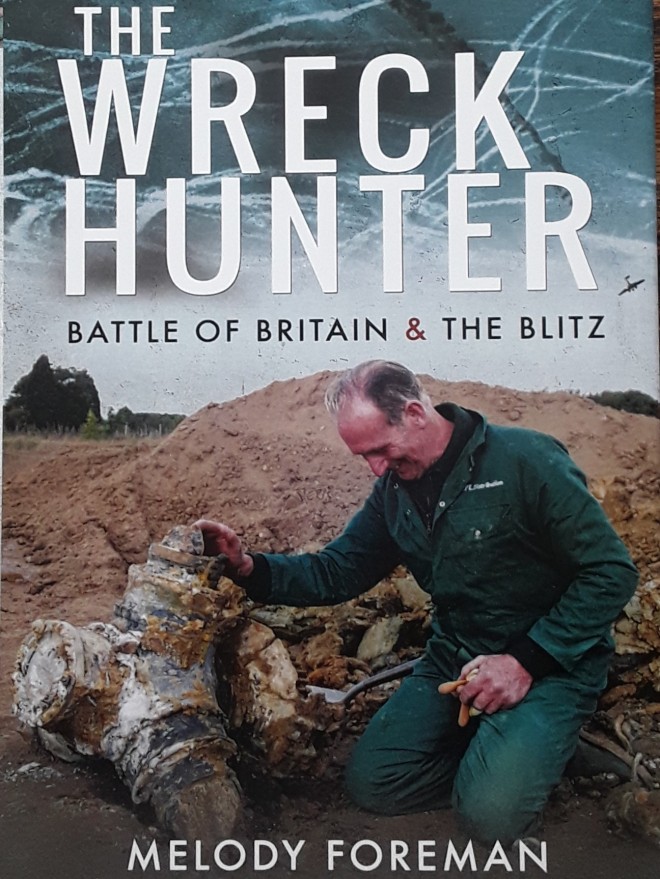
BOOK REVIEW
Reviewer: Michael Keith
Title: The Wreck Hunter: Battle of Britain & The Blitz
Author: Melody Foreman
Total Number of Printed Pages: 217
Rating Scale (1: Very Poor, 10: Excellent): 7
______________________________
When writing in this volume’s Foreword, Edward McManus (Historian and Committee Member Battle of Britain Monument London) states that ‘Probably the first person known to have embarked on researching and executing ‘digs’ is Terry Parsons’ and that ‘This book documents a selection of his most interesting…excavations over the years and the personalities , living and dead, that were drawn in’. It is an excellent summary of what is to follow.
The afore-mentioned Foreword is placed immediately behind the volume’s Contents page, and is followed by the book’s Introduction. Within this, the author details the both historical background to the wrecks described within the narrative and the current Governmental policies of care and protection which apply to both these unique items and their contents, with particular reference (in the latter case), to the human remains which are frequently found within such sites. The fourteen Chapters which comprise the largest part of the volume now appear. Chapter 1’s title (The First Wreck Hunters), while largely self-explanatory, does introduce the reader to the history of the recovery of crashed military aircraft (An ‘occupation’ dating back to World War I). It also introduces the volume’s ‘Hero’; Terry Parsons, and records the formative World War II events of his childhood; events which subsequently significantly affected his later life. In Chapter 2 (Boy of the Battle) Terry Parsons himself elaborates on these events, while simultaneously using actual Air Combat Reports and reminiscences to provide authority and background to the events that he was personally effected by. Chapters 3 (My First Dig) to 14 (Flying Heroes and the Giant Teapot), while following a similar format, are autobiographical in nature (although with added eye-witness accounts which led to that particular aircraft excavation), and were (according to the author’s note on page 208) taken directly from Mr Parson’s personal notes and diaries. This gives them an immediacy which takes the reader into the at-times complex world of aircraft wreck recovery. An Acknowledgements section follows Chapter 14.Within this, the author thanks those who contributed towards its creation. A small (thirteen-entry) Bibliography section follows, and this is in turn followed by the book’s final section; its’ Index. The volume contains numerous Quotes, Reminiscences and reproductions of newspaper clippings, letters and various official documents in supportive of the narrative. As these items do not however carry any supporting citations, their authenticity inevitably comes into question. Each Chapter is accompanied by supporting Photographs. These are monochrome in format and informatively captioned, but again, with only five exceptions, do not carry source citations. Neither the Contents Page nor the Index mentions the photographs’ existence. The volume contains no Maps.
For this reviewer, this was a ‘Muddle’ of a book; a volume trying to be several things at once and succeeding at none of them. It is simultaneously a biography, an autobiography, a reference work and (as shown in the first four sentences of Paragraph Four of Page 7), a work of uncritical adoration. The Index is problematical, and could most politely be described as being ‘Patchy’ in its content. Random searching produced many examples where terms used within the text were not to be found in the Index, those of Operation Nightingale, Richard Osgood, Stephen Macaulay and West Blatchington (all on page xiv) being but four examples. Curiously, the names of Harold Penketh and Vince Holyoak on the same page were accorded Index entries. The reasons for this contradiction on a single page is unknown, and as numerous other such ommissions were also found, the authority and veracity of the Index inevitably came into question. The already-noted lack of Source Citations for the numerous Quotes, Reminiscences, Letters and Official Documents together-with the book’s lack of Maps, further served to undermine such authority as the volume may have had. Is what is presented ‘true’, or imagined? In the absence of documentation to the contrary, there is no way to know! The caption A scene from Biggin Hill airfield in 1940 attached to the aircraft-related photograph appearing on page 22 also did nothing for the volume’s cause, the aircraft concerned being later model Spitfires and, on the presumption that the image is actually a genuine World War II image (rather than from a movie set) is one that was taken sometime after June 1944 (rather than as per the caption) as evidenced by the D-Day recognition stripes carried by the central machine. While it is possible that the original photograph might have been incorrectly captioned (and that a mistake made as a result), this discovery reduced confidence in the narrative still further. The author’s very-evident hero-worship and lack of objectivity was also unhelpful.
Despite its lack of authenticating documentation (Which diminishes its historical value substantially), this volume may be of interest to Archaeologists of all persuasions and aviation and military Historians, Readers with an interest in the Royal Air Force, the Battle of Britain and general military history and aviation, may also find it worthy of their attention. Despite the photographs being monochrome in format, aircraft modellers may find some of these useful for reference purposes.
On a Rating Scale where 1: Very Poor, 10: Excellent, I have given this volume a 7.
________________________________________







